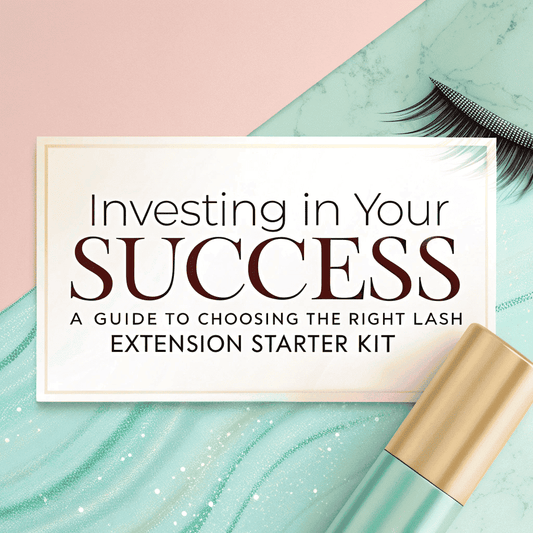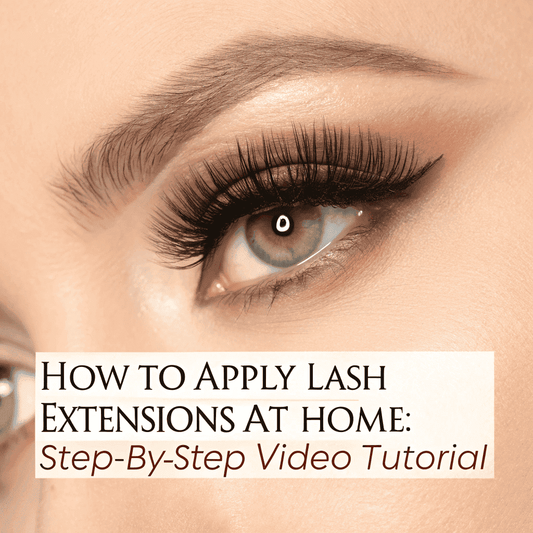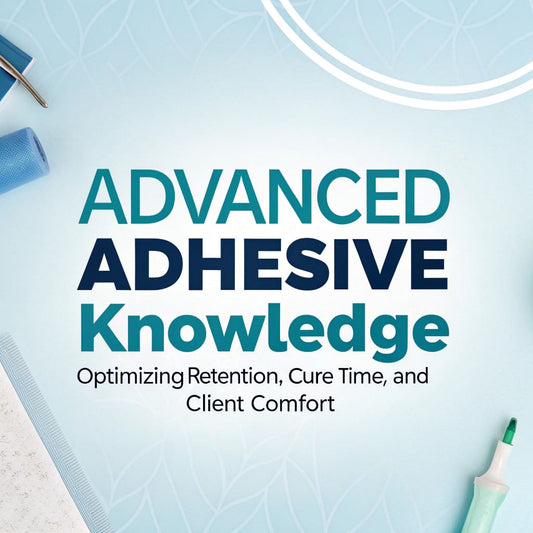Feeling lost choosing your first lash kit? Picking wrong wastes time and money. Let me guide you to the right starter kit for lash success.
Choosing the right lash extension starter kit is crucial. It equips you with essential tools and quality products. This sets a strong foundation for learning the art and building your lash business effectively from day one.

Getting started is exciting! But knowing *what* should be in your kit is key. Let's break down the essentials and help you make an informed choice for your new lash journey.
What are the essential tools included in a standard lash extension starter kit?
Overwhelmed by all the lash tools available? Buying unnecessary items or missing key ones is frustrating. Here are the absolute essentials every standard starter kit should contain.
A standard kit must include essentials like lash trays, tweezers (isolation and application), lash adhesive, adhesive remover, eye pads or tape, micro brushes, and lash brushes [^1]. These form the foundation for safe and effective application.
Understanding *why* each tool is essential helps you appreciate quality [^2]. Investing wisely here makes learning easier and your results more professional right from the start. Let's look closer at the core components:
Tweezers are Key
You absolutely need at least two types: an isolation tweezer (usually straight or slightly curved) to separate a single natural lash, and an application tweezer (often curved or L-shaped) to pick up and place the extension. Good tweezers should feel comfortable in your hand, have fine tips that close precisely, and offer a good grip without requiring too much pressure. Cheap, flimsy tweezers will cause endless frustration and make precise work nearly impossible. I remember struggling with poorly made tweezers when I first started – it made learning so much harder! Quality tools really make a difference [^3].
Lashes and Adhesive
A starter kit needs practice lashes. These are typically classic lashes (one extension per natural lash) in a common curl like C and a medium thickness like 0.15mm. You'll also need a suitable beginner-friendly adhesive – we'll discuss how to choose this later. Lash trays are included to hold the extensions neatly, making them easy to pick up [^1].
Preparation and Removal Tools
Proper preparation is crucial for good retention. A kit should include a lash cleanser or primer to ensure natural lashes are free of oils and debris. Under-eye gel patches or medical tape are essential to secure the lower lashes and protect the client's skin [^1]. Adhesive remover is also a must-have, not just for full removals, but for safely correcting any mistakes during application.
Application Aids
Small disposable tools make the process cleaner and more precise. Micro brushes are perfect for applying primer or remover sparingly [^1]. Lash brushes (like mascara wands, also called spoolies) are used to groom the lashes before, during, and after application [^1]. You'll also need something to hold your adhesive drop, like disposable adhesive rings or a lash palette [^1]. As a supplier at Universe Beauty Lashes, I always emphasize the importance of these basics – they directly impact your workflow and the final look.
How do I choose the right type of lashes for my clients based on their preferences and lash type?
Classic, Volume, Hybrid...confused about which lashes to use? Choosing incorrectly can lead to unhappy clients or lash damage. Let's clarify how to select the perfect lashes.
Select lashes by balancing the client's desired look (natural, dramatic) with their natural lash strength and length. Always prioritize the health of the natural lash when choosing curl, length, and diameter.

Choosing the right lash extension is truly an art form, blending the client's wishes with the reality of their natural lashes. It always begins with a thorough consultation. Don't just ask what look they want; really examine their natural lashes.
Key Lash Characteristics
Understanding these three elements is fundamental:
- Curl: This determines the lift and shape. Common curls range from J (slightest lift) and B (gentle lift) to C (popular, noticeable curl) and D (dramatic curl). There are also specialty curls like L or M. You should try to match the natural lash curl or choose one step curlier for a visible lift, but avoid overly curly extensions on very straight natural lashes as the bond might be weaker.
- Diameter (Thickness): This affects the weight and boldness. Diameters range from ultra-fine 0.03mm (for Mega Volume) up to 0.20mm or even 0.25mm (though these thicker classics are less common now due to weight). Classic lashes are typically 0.10mm, 0.12mm, or 0.15mm. Volume lashes use much thinner diameters (0.03mm, 0.05mm, 0.07mm) to create lightweight fans. The golden rule: never apply an extension that is too heavy for the natural lash to support.
- Length: Measured in millimeters, typically from 6mm to 18mm or longer. Choose lengths based on the client's natural lash length, eye shape, and desired style. Avoid extensions that are more than 2-3mm longer than the natural lash, especially on weaker lashes, to prevent strain or premature shedding. Most looks use multiple lengths for a natural taper.
Matching Lashes to Clients
Here's where consultation meets technical skill:
- Client Preference: Do they want a subtle enhancement or full-on glamour? A natural look often calls for Classic lashes that mimic their natural lash pattern. A dramatic look might require Volume or Mega Volume fans. Hybrid lashes (a mix of Classic and Volume) offer a popular textured look.
- Natural Lash Health: This is the *most* important factor. Fine, short, or weak natural lashes cannot safely support long, thick extensions. You *must* prioritize lash health over the client's desire for extreme drama if their lashes can't handle it. Educate your client gently. I once had a client insist on very long, thick lashes that were clearly too heavy for her fine natural lashes. I explained the risks and we agreed on a beautiful, slightly less dramatic set that wouldn't cause damage.
Common Lash Extension Types
| Lash Type | Description | Best For |
|---|---|---|
| Classic | One single extension applied to one single natural lash. | Natural enhancement, clients with dense natural lashes. |
| Volume | A handmade fan of multiple very fine extensions (2-10+ lashes, 0.03-0.07mm diameter) applied to one natural lash. | Dramatic, full look; good for clients with sparse natural lashes to create fullness. |
| Hybrid | A mixture of Classic lashes and Volume fans applied throughout the set. | Textured, wispy look; fuller than Classic but less dense than full Volume. |
| Easy Fan | Volume lashes with a unique sticky base that helps them spring into a fan shape easily when picked up. | Lash artists learning the Volume technique, faster Volume application. |
How do I select the right adhesive for my lash extension applications?
Lash glue seems tricky, right? Choose wrong, and lashes fall off fast, or clients react badly. Let's simplify how to pick the perfect adhesive for your needs.
Select adhesive based on your application speed (drying time), your work environment's humidity/temperature, and client sensitivity (fume level). Beginners usually need a slower-drying glue for more placement time.
Lash adhesive is arguably the most critical product in your kit. It dictates retention, application ease, and client comfort. Making an informed choice is non-negotiable for professional results.
Key Adhesive Factors
Consider these properties when choosing a glue:
- Drying Time: This is how quickly the adhesive cures (hardens). Times range from almost instant (0.5-1 second) for highly experienced techs to much slower (3-5+ seconds) for beginners. As a novice, you need more time to isolate correctly and place the extension accurately before the glue sets. Starting with a glue that's too fast will lead to poor bonds and frustration. You can transition to faster glues as your speed and confidence increase.
- Viscosity (Thickness): Adhesives vary from very thin and watery to slightly thicker and more gel-like. This is often a matter of personal preference. Thinner glues tend to dry faster and wick up the lash less, while slightly thicker glues might offer a tiny bit more placement time.
- Fumes & Sensitivity: All professional lash adhesives are cyanoacrylate-based, which means they produce fumes that can potentially irritate eyes or skin. Some adhesives are formulated to have lower fumes ("sensitive" glues). However, these often compromise on drying time and bond strength, leading to poorer retention. Always work in a well-ventilated space. A patch test is recommended for new clients or those with known sensitivities.
- Humidity & Temperature Range: This is crucial! Every adhesive has an optimal range of humidity and temperature in which it performs best. If your room is too humid, the glue might cure too quickly on the outside ("shock cure"), leading to a weak bond. If it's too dry, it might cure too slowly. Check the manufacturer's specifications for the glue you choose and use a hygrometer to monitor your workspace conditions. Adjusting your room's climate or choosing a glue suited to your environment is key.
Matching Adhesive to Your Needs
Use this table as a guide:
| Factor | Consideration | Recommendation |
|---|---|---|
| Skill Level | Your speed and precision | Beginner: Slower dry time (3-5 sec). Intermediate/Expert: Faster (0.5-2 sec). |
| Work Environment | Room Humidity & Temperature | Use a hygrometer. Choose adhesive designed for your typical room conditions (check manufacturer specs). |
| Client Sensitivity | Known allergies, eye sensitivity | Patch test 24-48 hrs prior. Consider a sensitive glue if necessary but manage client expectations regarding retention. Ensure good ventilation. |
| Desired Retention | Bond strength and longevity | Generally, faster-drying, non-sensitive glues offer the strongest bond (when used correctly). Balance this with your skill level and client factors. |
As a supplier, providing fresh, high-quality adhesive like we do at Universe Beauty Lashes is a top priority for me. Old or improperly stored adhesive is a major reason for poor retention, regardless of your skill. Always check the expiration date and follow storage guidelines (cool, dark place, often airtight container with silica gel).
What are some common mistakes beginners make when starting with lash extensions, and how can they be avoided?
Worried about making mistakes as a lash beginner? Bad habits can hurt clients and your reputation. Let's identify common errors so you can avoid them [^4].
Common beginner mistakes include poor isolation (stickies), incorrect placement, using too much glue, wrong lash/adhesive choice, and inadequate preparation [^4]. Avoid these through proper training, patience, and focused practice [^5].
%[Illustration showing common lash mistakes like stickies or bad placement](https://placehold.co/600x400)
Learning any intricate skill involves a learning curve, and lash extensions are no different. Being aware of the most common pitfalls can help you navigate this phase more smoothly and build good habits from the start.
Poor Isolation (Stickies)
This is perhaps the most critical error. It involves failing to perfectly isolate a single natural lash before applying an extension [^4]. When extensions are glued to multiple natural lashes (or natural lashes are glued together), it's called a "sticky." Stickies prevent natural lashes from shedding independently, causing discomfort, pulling, and potential damage to the hair follicle.
How to Avoid: Invest in quality isolation tweezers that allow you to get a clear view. Use bright lighting and magnification if needed. Work methodically. Take your time – speed comes later. Constantly check your work for stickies before moving on. Practice isolation drills on a mannequin head or sponge.
Incorrect Placement
Placing the extension too far from the lash line (more than 1-1.5mm) leads to a droopy look and poor retention as it grows out quickly [^4]. Placing it too close (touching the skin) can block the follicle, cause irritation, and potentially lead to allergic reactions [^4]. The attachment angle also matters; the extension base should be fully bonded along the natural lash base.
How to Avoid: Aim for the sweet spot: 0.5mm to 1mm away from the eyelid. Ensure the base of the extension makes secure contact with the natural lash. Quality training is essential here to learn the correct technique [^5]. Use a lash mirror periodically to check your placement from different angles.
Using Too Much or Too Little Glue
Using excessive adhesive creates visible clumps, adds unnecessary weight to the natural lash, and can cause stickies by bridging gaps between lashes. Using too little glue results in a weak bond and extensions that shed prematurely.
How to Avoid: Aim for a micro-bead of adhesive, just enough to coat the base of the extension (about 1-2mm). Dip the extension base into the glue drop smoothly; don't scoop. Practice the dipping motion until it becomes consistent. The right amount often looks like almost nothing!
Wrong Lash/Adhesive Choice
As discussed earlier, selecting lashes that are too long or too thick for the natural lash can cause damage [^4]. Using an adhesive that dries faster than your application speed will result in poor bonding [^4].
How to Avoid: Always assess the client's natural lashes first. Prioritize lash health. Start with a beginner-friendly adhesive (slower drying time) and conservative lash choices (moderate length/diameter). Refer back to the sections on choosing lashes and adhesive.
Inadequate Preparation or Aftercare Advice
Starting application on lashes that aren't perfectly clean (residual makeup, oils) will compromise the adhesive bond significantly. Equally important is educating your client on how to care for their extensions. If they don't follow aftercare, retention will suffer, and they might blame your work.
How to Avoid: Always cleanse the client's lashes thoroughly with a lash-safe cleanser before starting. Provide clear, concise aftercare instructions both verbally and in writing (e.g., avoid oil-based products, cleanse daily, brush gently, avoid rubbing/pulling).
My best advice? Be patient with yourself during the learning process. Invest in a reputable training course – it's non-negotiable [^5]. Practice diligently, even if it's just on a mannequin head initially. Don't be afraid to seek mentorship or connect with other lash artists. We all started somewhere, and persistence pays off!
Are there specific tools included in Premium kits that aren't in Classic kits?
Wondering if you need a Premium starter kit, or if Classic is enough? Spending more isn't always better, but are you missing out? Let's compare the typical differences.
Yes, Premium kits often include extras not found in basic Classic kits. This might mean more lash variety (different curls/lengths), higher-grade tweezers, specialized tools (like nano misters), or larger quantities.

While a standard or 'Classic' starter kit focuses on providing the absolute bare essentials you need to begin learning and practicing lash application, 'Premium' or 'Deluxe' kits typically offer more. The goal of a premium kit is often to provide greater value, more variety, higher quality components, or tools that facilitate more advanced techniques or client comfort. The exact contents will vary significantly between suppliers, but let's explore the common upgrades or additions you might find:
Potential Premium Kit Additions
- More Lash Variety: Instead of just one or two trays of basic C curl lashes, a premium kit might include multiple trays featuring different curls (like D curl), mixed-length trays (which are very practical for creating natural styles), or even different diameters (perhaps including 0.07mm for practicing Volume basics or 0.10/0.12mm for finer Classic work).
- Higher Quality Tools: This is a frequent upgrade. Tweezers might be made from higher-grade steel (like German or Japanese steel), offering better precision, lighter tension, or specific branded designs known for quality. The finish and balance might be superior.
- Specialized Tools & Accessories: You might find items like a nano mister (used at the end of the service to help cure the adhesive rapidly, reducing fumes and improving retention), higher-quality eye pads (e.g., thinner, better shaping, collagen-infused), a lash mirror (for checking work from the client's perspective), or a crystal lash palette (considered more hygienic and easier to clean than disposable options).
- Larger Quantities: Premium kits might simply offer more of the basics – a larger bottle of adhesive, more lash trays, larger packs of disposables like micro brushes, spoolies, or gel pads.
- Advanced Consumables: Items sometimes omitted from basic kits might be included, such as lash primer (for optimal pH balance before application), lash sealant (to extend retention), or different types of adhesive remover (e.g., both gel and cream removers).
Is Premium Worth It?
The value depends on your goals and budget. If you are certain about your commitment to lashing, plan to quickly explore different styles (like Hybrid or Volume), and appreciate having higher-grade tools from the outset, a premium kit could potentially save you money compared to buying all the extras individually later. However, if you're starting on a tight budget or are just testing the waters, a well-curated Classic kit containing high-quality *essentials* is perfectly sufficient [^6]. You can always purchase additional lash types, upgraded tweezers, or specialized tools as you progress and identify specific needs. Don't feel pressured to buy the most expensive kit if a solid basic one covers the necessary fundamentals.
Classic vs. Premium Kit Comparison (Typical)
| Item | Classic Kit (Typical) | Premium Kit (Typical Additions/Upgrades) |
|---|---|---|
| Lash Trays | 1-2 (e.g., C curl, 0.15mm diameter) | 3+ trays (e.g., Mixed lengths, C & D curls, maybe 0.07mm or 0.10mm diameters) |
| Tweezers | Standard quality Isolation & Application tweezers | Higher Grade steel, potentially extra styles (e.g., specific Volume tweezer) |
| Adhesive | Small bottle (e.g., 5ml), beginner-friendly dry time | Potentially larger bottle (10ml), maybe includes a faster-drying option too |
| Extras | Basic disposables (pads, tape, brushes) | Nano Mister, Primer, Sealant, Lash Mirror, larger quantity/higher quality disposables |
My personal advice, drawing from my experience at Universe Beauty Lashes supplying many new lash artists? Focus first on a kit that provides high-quality *essential* tools, especially tweezers and a fresh, suitable adhesive [^6]. Mastering the fundamentals is key. Once you've built a solid foundation, you'll have a much better understanding of which specific premium tools or lash varieties will truly benefit your work and are worth the additional investment.
Conclusion
Choosing the right starter kit sets you up for success. Focus on quality essentials first, understand your needs for lashes and adhesive, learn from common mistakes, and invest wisely in your lash artistry journey.
Footnotes
[^1]: Essential lash extension accessories include lash trays, adhesive rings, lash palettes, micro brushes, lash brushes, and gel patches. (Source: Reference Material 5)
[^2]: Investing in high-quality lash extension accessories is essential for ensuring precise and efficient application... (Source: Reference Material 4)
[^3]: Choosing reliable and high-quality lash extension accessories is crucial for achieving professional results... (Source: Reference Material 6)
[^4]: Beginners may make mistakes such as improper isolation, incorrect placement, using the wrong adhesive or lash type... (Source: Reference Material 2)
[^5]: Invest in proper training... Practice regularly... (Source: Reference Material 3)
[^6]: Key considerations when choosing lash extension accessories include quality, compatibility, functionality... (Source: Reference Material 1)





